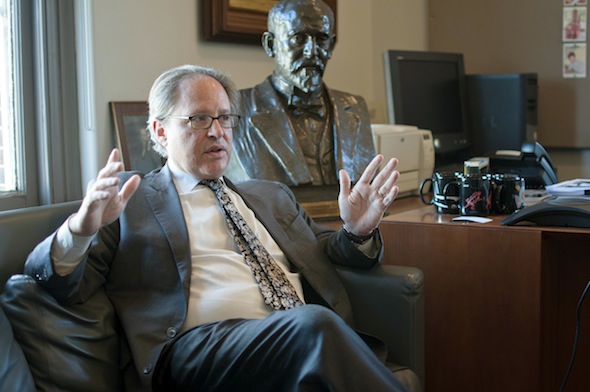
Nicholas Lemann, dean of the Columbia Journalism School, has decided to head back to the classroom after 10 years in the corner office overlooking College Walk. Before bringing the J-School into the 21st century, Lemann forged a career at smart, influential magazines (The Washington Monthly, Texas Monthly, The Atlantic, and, yes, The New Yorker, where he remains a staff writer); he also wrote several books. Cyndi Stivers emailed Lemann questions shortly after he presided over his final commencement in May. “One of the great pleasures of being at the Journalism School for a while,” he said, is that “almost daily, you come upon the work of one of your former students in the course of doing your ordinary journalistic reading.”
Ten years is a nice round number, but why did you decide now not to re-up? The obvious answer is that we’re just completing our fundraising campaign. That’s a good stopping point, and I don’t think it’s fair to my successor to plan the next campaign’s themes and leave it to him to execute–it should be completely his show. More broadly, I think it’s better for an institution of the size of the Journalism School to have a smooth leadership transition every ten years or so than to have one person stay as dean for a very long time. Also, I’d like to return to writing books.
The journalism business certainly looks different than it did when you began as dean. How has the job/the school/the student body changed over the past decade? The main changes in the student body are that it has become more international, and that interest in digital journalism has increased. The main change in the school is that it has grown significantly by most measures–budget, student body, range of programs. The main change in journalism has been the influence of the Internet, which has been great in every way except as regards the economics of mainstream news organizations.
What is your own daily media menu, and how has it evolved during this period? I am online ingesting media all day long. Little of my menu would surprise you, and giving the whole thing would be boring, so I’d like to highlight especially aggregation sites that survey and curate a wide range of material for you (my favorites are RealClearPolitics and Arts & Letters Daily), and expert blogs like The Monkey Cage, Balkinization, scotusblog, and OnEarth.
How (and for what) do you hope your tenure will be remembered? For bringing the Journalism School more into the orbit of the wider university, especially by dialing up the intellectual content of the curriculum, and for finding what I hope is the right way to position ourselves in the digital revolution.
What do you regret not getting to do, or to finish? Je ne regrette rien.
What are your plans for the summer, and when you return to the classroom (which is when?), what will you be teaching? Over the summer, I’ll be mainly at our house in the Catskills. I am working on a New Yorker assignment, the 2014 Tanner Lectures at Stanford, and, with two former-dean colleagues, a Carnegie Corporation-funded report on the future of journalism education. When I return to teaching in 2014-15, I’ll teach whatever the dean wants me to teach, but I’d like to return to my Evidence and Inference course and Art and Science of the Interview, if possible.
What’s your advice for Steve Coll–besides maintaining enough distance from CJR’s editorial planning to ensure plausible deniability? When I came to Columbia, the then-dean of Columbia Law School, David Leebron, who’s now president of Rice University in Houston, took me to lunch, and I asked him this question. He said, “Always make it look like you’re having fun, even if you’re not.” That’s pretty hard to beat.
Cyndi Stivers is a former editor in chief of CJR
